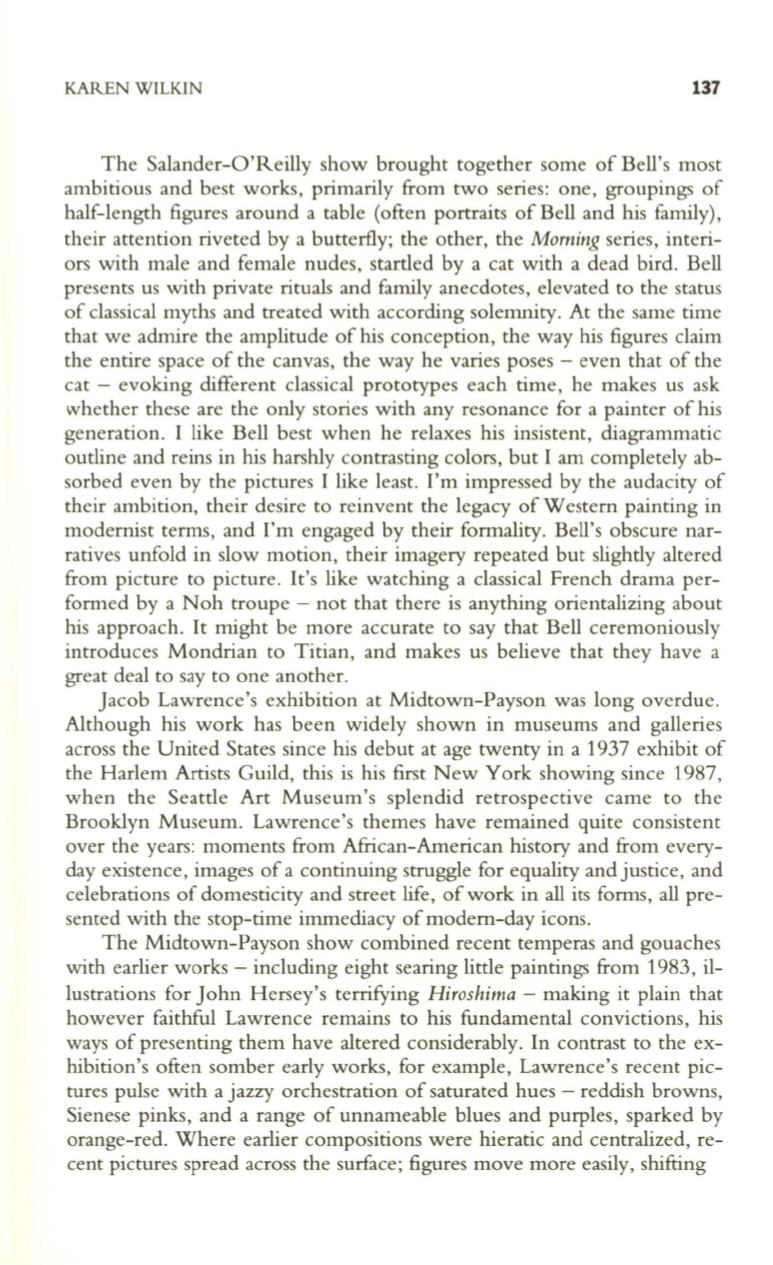
KAREN WILKIN
137
The Salander-O'Reilly show brought together some of Bell's most
ambitious and best works, primarily from two series: one, groupings of
half-length figures around a table (often portraits of Bell and his family),
their attention riveted by a butterfly; the other, the
Morning
series, interi–
ors with male and female nudes, startled by a cat with a dead bird. Bell
presents us with private rituals and family anecdotes, elevated to the status
of classical myths and treated with according solemnity. At the same time
that we admire the amplitude of his conception, the way his figures claim
the entire space of the canvas, the way he varies poses - even that of the
cat - evoking different classical prototypes each time, he makes us ask
whether these are the only stories with any resonance for a painter of his
generation. I like Bell best when he relaxes his insistent, diagrammatic
outline and reins in his harshly contrasting colors, but I am completely ab–
sorbed even by the pictures I like least. I'm impressed by the audacity of
their ambition, their desire to reinvent the legacy of Western painting in
modernist terms, and I'm engaged by their formality. Bell's obscure nar–
ratives unfold in slow motion, their imagery repeated but slightly altered
from picture to picture. It's like watching a classical French drama per–
formed by a Noh troupe - not that there is anything orientalizing about
his approach. It might be more accurate to say that Bell ceremoniously
introduces Mondrian to Titian, and makes us believe that they have a
great deal to say to one another.
Jacob Lawrence's exhibition at Midtown-Payson was long overdue.
Although his work has been widely shown in museums and galleries
across the United States since his debut at age twenty in a 1937 exhibit of
the Harlem Artists Guild, this is his first New York showing since 1987,
when the Seattle Art Museum's splendid retrospective came to the
Brooklyn Museum. Lawrence's themes have remained quite consistent
over the years: moments from Mrican-American history and from every–
day existence, images of a continuing struggle for equality and justice, and
celebrations of domesticity and street life, of work in
all
its forms, all pre–
sented with the stop-time immediacy of modern-day icons.
The Midtown-Payson show combined recent temperas and gouaches
with earlier works - including eight searing little paintings from 1983, il–
lustrations for John Hersey's terrifying
Hiroshima
-
making it plain that
however faithful Lawrence remains to his fundamental convictions, his
ways of presenting them have altered considerably. In contrast to the ex–
hibition's often somber early works, for example, Lawrence's recent pic–
tures pulse with a jazzy orchestration of saturated hues - reddish browns,
Sienese pinks, and a range of unnameable blues and purples, sparked by
orange-red. Where earlier compositions were hieratic and centralized, re–
cent pictures spread across the surface; figures move more easily, shifting


